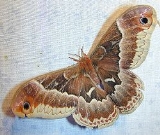
Callosamia promethea
Encyclopedia
The Promethea Silkmoth (Callosamia promethea), is a member of the Saturniidae
family of moths.
and lower parts of eastern Canada
.
Saturniidae
The Saturniidae, commonly known as saturniids, are among the largest and most spectacular of the moths. They form a family of Lepidoptera, with an estimated 1,300 to 1,500 described species worldwide...
family of moths.
Description
Males have dark brownish-black wings with a faint white postmedian line and pinkish coloring near the apical spot. Females are bright reddish-pink or a brownish color with well-developed reniform spots. Both sexes have tanish marginal borders. Their wingspan measures 7.5-9.5 cm.Range
C. promethea is found in the eastern half of the United StatesUnited States
The United States of America is a federal constitutional republic comprising fifty states and a federal district...
and lower parts of eastern Canada
Canada
Canada is a North American country consisting of ten provinces and three territories. Located in the northern part of the continent, it extends from the Atlantic Ocean in the east to the Pacific Ocean in the west, and northward into the Arctic Ocean...
.
Life cycle
Mating takes place in the afternoon to early evening, and egg-laying begins at night. Females are attracted to lights, but males are not. Females lay 2-12 eggs in a singe cluster on host plants. The early instar larvae feed together on the underside of leaves. They are greenish yellow and striped with black. The older larvae are solitarty and are almost all green except for 4 red knobs above the thorax and 1 yellow knob on the eighth abdominal segment. On the lower branches of the food plant, the larva makes a cocoon within a leaf, firmly attaching the petiole to the branch. C. promethea has 1 brood in the north (which flies from June-July) and 2 or more broods in the south (which flies from March-May and again from July-August).Food Plants
The larvae of C. promethea feed on a variety of plants including- but not restricted to- the following:- Acer, (maple)
- DiospyrosDiospyrosDiospyros is a genus of about 450–500 species of deciduous and evergreen trees. The majority are native to the tropics, with only a few species extending into temperate regions. They are commonly known as ebony or persimmon trees...
, (persimmon) - Fraxinus americana, (white ash)
- KalmiaKalmiaKalmia is a genus of about 8 species of evergreen shrubs from 0.2–5 m tall, in the family Ericaceae. They are native to North America and Cuba. They grow in acidic soils, with different species in wet acid bog habitats and dry, sandy soils Kalmia is a genus of about 8 species of evergreen shrubs...
, (laurel) - Lindera benzoinLindera benzoinLindera benzoin is a flowering plant in the family Lauraceae, native to eastern North America, ranging from Maine to Ontario in the north, and to Kansas, Texas and northern Florida in the south.-Characteristics:Spicebush is a medium-sized deciduous shrub growing to 5 m...
, (spicebush) - Liriodendron tulipiferaLiriodendron tulipiferaLiriodendron tulipifera, commonly known as the tulip tree, American tulip tree, tuliptree, tulip poplar or yellow poplar, is the Western Hemisphere representative of the two-species genus Liriodendron, and the tallest eastern hardwood...
, (tulip tree) - MalusMalusMalus , the apples, are a genus of about 30–35 species of small deciduous trees or shrubs in the family Rosaceae. Other studies go as far as 55 species including the domesticated Orchard Apple, or Table apple as it was formerly called...
, (apple) - Pinus, (pine)
- Populus, (poplar)
- Prunus persica, (peach)
- Prunus serotina, (wild black cherry)
- Pyrus, (pear)
- Quercus, (oak)
- RhododendronRhododendronRhododendron is a genus of over 1 000 species of woody plants in the heath family, most with showy flowers...
- Salix, (willow)
- SassafrasSassafrasSassafras is a genus of three extant and one extinct species of deciduous trees in the family Lauraceae, native to eastern North America and eastern Asia.-Overview:...
- Syringa, (lilac)
- TiliaTiliaTilia is a genus of about 30 species of trees native throughout most of the temperate Northern Hemisphere. The greatest species diversity is found in Asia, and the genus also occurs in Europe and eastern North America, but not western North America...
, (basswood)
External links
- Callosamia promethea, Butterflies & Moths of North America

